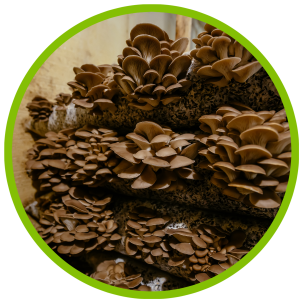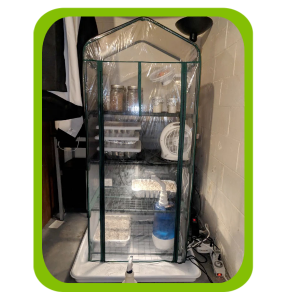Home Cultivation Methods
Home Cultivation Methods

**VIDEO BELOW
There are a variety of methods used to cultivate mushrooms at home. One important point: not all mushrooms will grow in all substrates! Fungi can be as picky about their environment as some people, so it’s very important to choose your method and substrate based on the mushroom you want to grow.
Oysters, with the exception of the Black Pearl, will grow on just about anything, including cardboard. Shiitake and lion’s mane however, will typically grow only on logs or supplemented hardwood. And there are a few species-specific points, such as smacking and shocking your shiitakes into fruiting. Yes-we physically hit the shiitake block, and stick it in the fridge for 12-24 hours! This variation is why it’s important to consult a good reference for more detailed information. Several are given in the References section.
Another very important thing to do is label. Label everything! Record variety, date of inoculation, and if applicable, spawn generation number. Keeping detailed lab notes will help you remember what worked well and most importantly, what didn’t. The Internet can be a huge mass of conflicting information, and once your operation expands there’s no way to remember every single detail. My home cultivation operation started with one table top lion’s mane farm. I now have four species of mushroom, nearly one dozen spawn jars of different generations, half a dozen supplemented sawdust blocks in various stages of colonization, and a set of agar plates. And I’m still expanding! Trust me: labeling and documentation are crucial!
Cultivation Lessons
Making and Inoculating Sawdust Blocks (oysters, shiitake, maitake, lion’s mane etc.)
Growing on Logs (shiitake, maitake, lion’s mane etc.)
Martha Tents

Martha Tent
These wonderful items are a standard plastic mini greenhouse repurposed for mushroom cultivation. The artificial environment allows for greater temperature and humidity control, and they fit well into closets and other small spaces. These are very useful for storing fruiting trays, blocks, and jars.
For the DIY crowd, all you need is the greenhouse, a 4” duct fan, drip tray, filter patch for fan, humidity controller/ultrasonic humidifier, hose clamp, filter. A pond filter can be used but those are rather unreliable. The fan keeps fresh air flowing so CO2 levels don’t rise to the point of preventing fruiting. Setting it up as a negative pressure system is best so the air flows from the bottom to the top and out. It is possible to duct fan outflow outside through window if you have one, otherwise use a filter and hose clamp to catch spores coming out of Martha tent.
You’ll want to keep tent out of direct sunlight to keep the fruiting temperatures in the cooler range and also keep the substrate from drying out. We all know how hot the inside of a greenhouse can get! And don’t cram your tent full! Good air flow solves many problems.
There are many great DIY videos out there, including the North Spore site in the References list.
Martha Tent Setup Video
Download Video Transcript HERE
Kits vs DIY
For the beginning cultivator, kits can be a very cost-effective way to get started. My first table top farm yielded a market value of $1400 in tincture, saving me a great deal of money over buying it. Kits are also a great way to get all of the items needed in one transaction, often at a reduced rate when compared with buying separately. Kits are available for everything from sawdust blocks to monotubs! I suggest looking at the websites mentioned in the references, though by no means are these the only reputable sellers available. Kits can also help the beginning cultivator learn the finer points of the cultivation process. Some items, such as liquid culture and agar plates, are very time-consuming to make and much more efficient to buy.
DIY can be cheaper than kits in many ways and can be the only way to obtain items such as a Martha tent. I enjoy making my own sawdust blocks and spawn, and find the end result very satisfying. DIY helps cultivate the “I can” mind and a self-reliant habit. Basically, you’re investing time rather than money vs kits, where you’re investing money rather than time. Either way works! There’s something to be said for doing it yourself, and there’s benefit in simplicity as well. Choose your method and go with it!
Summary
This lesson has provided a general overview of the most common methods used in home mushroom cultivation. Mushrooms can also be grown in compost piles, bottles, coffee grounds, cardboard, and in your lasagna garden beds. For more detail I refer you to Bray and Stamets, the former being an easier read for the home cultivator while the latter goes into incredibly lovely detail. Go for it!

